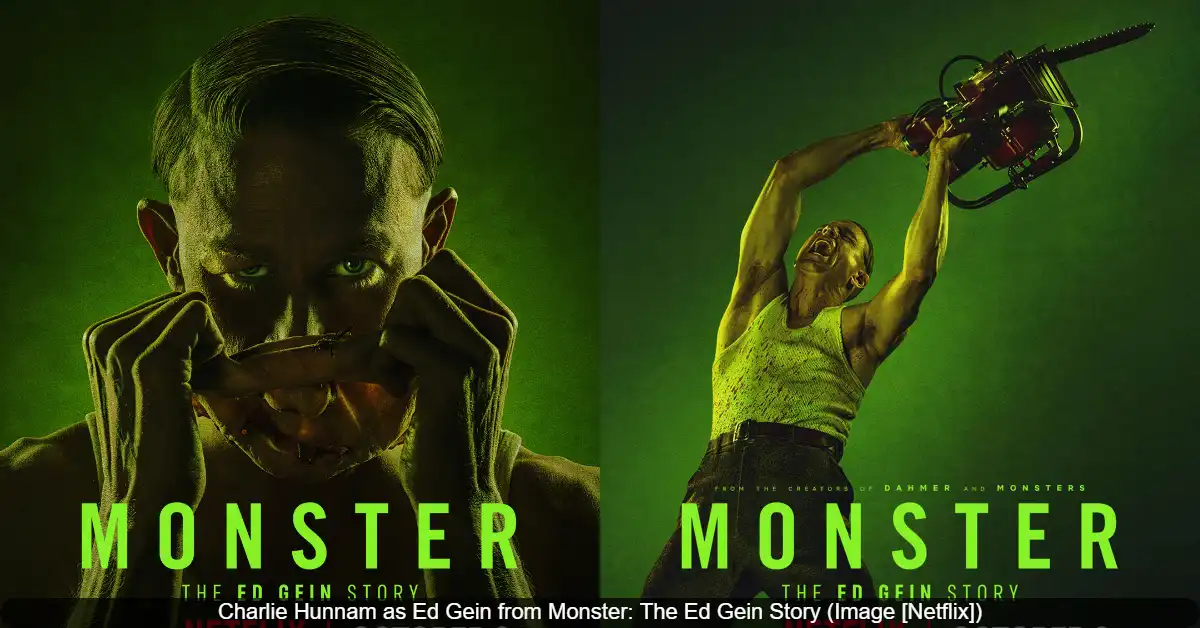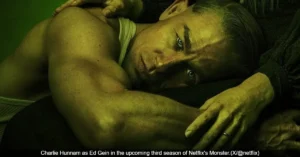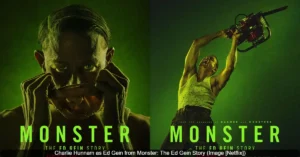The terrifying monsters from The Texas Chainsaw Massacre, Psycho, and The Silence of the Lambs have one thing in common: they are all based on the real-life story of Ed Gein, a reclusive farmer from Wisconsin. His gruesome crimes in the 1950s created a blueprint for the American horror genre, influencing filmmakers for decades. The new Netflix series Monster: The Ed Gein Story, starring Charlie Hunnam, explores the man behind the movie monsters.
The Real Story of Ed Gein
Ed Gein was a mild-mannered handyman and babysitter who lived on a secluded farm in Plainfield, Wisconsin. In 1957, the disappearance of a local store owner, Bernice Worden, led police to his property, where they made horrifying discoveries that would shock the nation.
Authorities found Worden’s body in a shed, and inside Gein’s house, they uncovered a collection of macabre artifacts made from human remains. These included chairs upholstered with human skin, a belt made from human nipples, skulls mounted on bedposts, and faces crafted into masks. Gein confessed to killing Worden and another woman, Mary Hogan, and to robbing graves from local cemeteries to collect his materials. He was diagnosed with chronic schizophrenia, found not guilty by reason of insanity, and spent the rest of his life in psychiatric hospitals until his death in 1984.
Gein’s deeply troubled childhood was a key factor in his psychological state. He was dominated by his fanatically religious mother, Augusta, who taught him that women and sex were evil. After her death, his mental health deteriorated, and his obsession with her led him to target women who resembled her.
“He was the inspiration for Alfred Hitchcock’s ‘Psycho,’ Buffalo Bill in ‘Silence of the Lambs’ and ‘Texas Chainsaw Massacre,’ so he had this huge cultural influence,” Charlie Hunnam, who plays Gein in the new series, told a major news outlet.
The Birth of Norman Bates in ‘Psycho’
The connection between Gein and Norman Bates, the iconic killer from Alfred Hitchcock’s Psycho, is direct. Author Robert Bloch wrote the novel Psycho just a few years after Gein’s crimes were uncovered and lived only 35 miles from Plainfield.
Both Norman Bates and Ed Gein were reclusive, mother-obsessed men who preserved rooms in their homes as shrines to their deceased mothers. In the film, Norman Bates is shown wearing his mother’s clothes, a fictional echo of Gein’s real-life creation of a “woman suit” from human skin. The eerie, Gothic appearance of the Bates house in Psycho also drew inspiration from the visual of Gein’s isolated farmhouse.
The film’s release fundamentally changed the horror genre. Before Psycho, movie monsters were often external creatures like vampires or werewolves. Hitchcock’s film introduced the terrifying concept that the monster could be the quiet, unassuming person living next door.
The Creation of Leatherface in ‘The Texas Chainsaw Massacre’
The hulking, chainsaw-wielding Leatherface from The Texas Chainsaw Massacre is another character directly inspired by the details of Gein’s life. The film’s director, Tobe Hooper, learned about Gein as a child from relatives who lived in Wisconsin.
“They told us the story about this man who lived in the next town from them… who was digging up graves and using the bones and skin in his house. That was all I knew about it… But to me he was like a real boogeyman,” Hooper recalled in an interview.
Leatherface’s practice of wearing a mask made of human skin is a direct reference to the human face masks found in Gein’s home. The film’s depiction of victims being hung on meathooks mirrors the police discovery of Bernice Worden’s body, which was hung by her heels in a shed, dressed like a deer. The Sawyer family’s house in the film, cluttered with bones and macabre decorations, recreates the shocking state of Gein’s “house of horrors.”
Inspiring Buffalo Bill in ‘The Silence of the Lambs’
The villain Jame Gumb, also known as Buffalo Bill, in The Silence of the Lambs completes the trifecta of Gein-inspired characters. While the character also drew from other serial killers, his most infamous trait comes straight from the Gein case.
Buffalo Bill’s goal is to create a “woman suit” from the skin of his victims, a horrifying concept that Thomas Harris adapted for his novel after learning about Gein’s real-life experiments. Among the items found in Gein’s home was a vest or suit made from human skin, which he would reportedly wear. This detail provided the core motivation for the film’s central villain, making the character one of the most memorable in cinematic history.
A Lasting and Dark Cultural Impact
The legacy of Ed Gein’s crimes extends far beyond these three films. His story has influenced dozens of other movies, television shows, and books, establishing a recurring trope in horror: the disturbed, mother-fixated killer. This influence is examined in the new Netflix series, which also looks at how Gein’s own fascination with violent pop culture and news stories may have fueled his actions.
“This whole series, it turns the camera right on us,” said Ian Brennan, co-creator of the Monster anthology. “It really matters what you look at and the images and stories you consume. They do stick with you, and they do have an impact.”
The small town of Plainfield was forever changed by Gein’s actions. His farmhouse, which became known as a “house of horrors,” was destroyed by a fire in 1958. Today, a museum in Savannah, Georgia, called The Graveface Museum, hosts “The Ed Gein Experience,” displaying unpublished crime scene photos and the only remaining piece of evidence from the case.
Also Read: Monster: The Ed Gein Story Draws 12.2 Million Viewers in Competitive Netflix Debut
Credits: Deadline, Today.com, Vanity Fair












